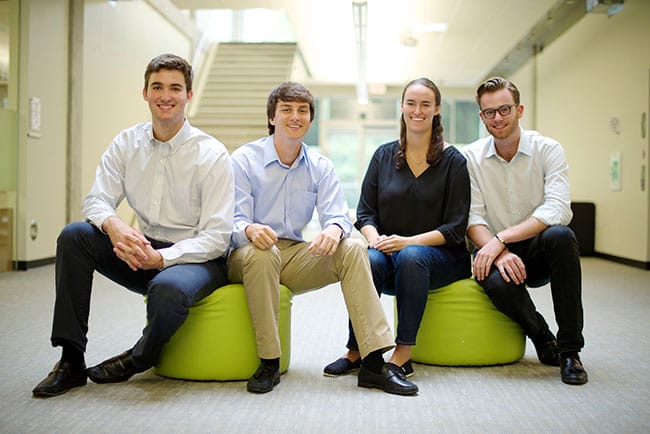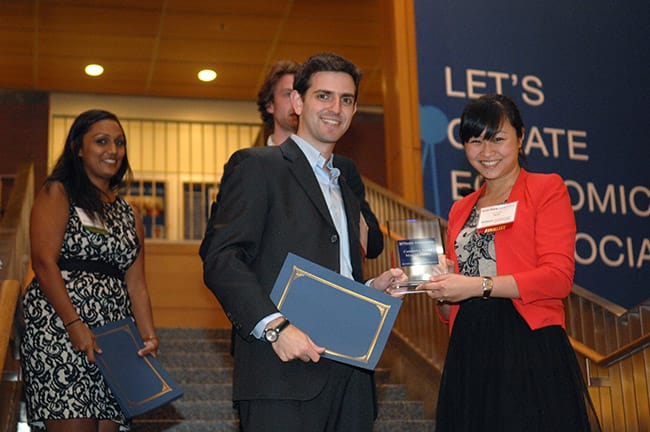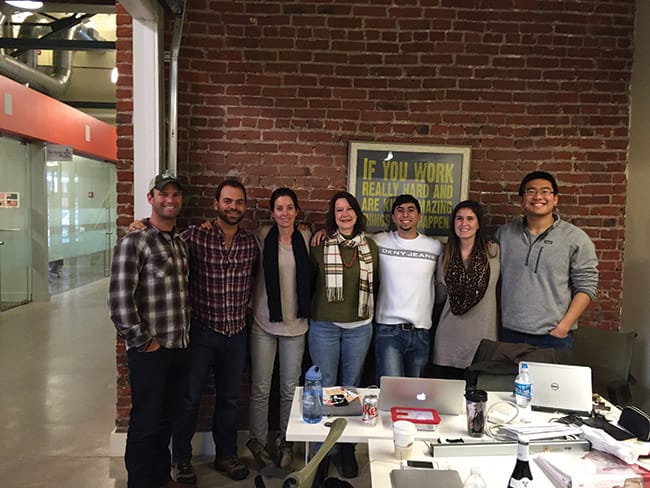ChargeItSpot
 It seems as though every third startup these days involves charging an iPhone. There are devices that will power up your phone from a campfire, from solar panels on your backpack and from the spinning of a gym treadmill. On the surface, ChargeItSpot appears to be in the mobile phone charging business too, but look closely, and you’ll see a sophisticated, analytically oriented play aimed at the retailing industry that’s well on its way to success.
It seems as though every third startup these days involves charging an iPhone. There are devices that will power up your phone from a campfire, from solar panels on your backpack and from the spinning of a gym treadmill. On the surface, ChargeItSpot appears to be in the mobile phone charging business too, but look closely, and you’ll see a sophisticated, analytically oriented play aimed at the retailing industry that’s well on its way to success.
ChargeItSpot sets up a sleek kiosk in stores so that shoppers can charge their depleted mobile phones free of charge while they browse. The store pays ChargeItSpot to set up a kiosk. Why? Because, says founder Douglas Baldasare WG12, users inevitably stick around and get some shopping done while waiting for their phones to charge.
“They end up spending 29 percent more in the store, and are 54 percent more likely to buy something,” he says, citing data provided by Gfk, the San Francisco-based market research firm.
That can add up to $80,000 in additional annual revenue per store—one reason that Bergdorf-Goodman, Urban Outfitters and Staples are now among the 120 locations in 13 states using the service.
Besides the convenience the kiosks offer, another key to the acceptance of ChargeItSpot’s units is that they are attractively designed to blend into just about any retailing environment. Sonic Design of Brooklyn was hired to do the styling. It came up with a design that left ample room for the store to post its own logos and marketing material. The design left another option too; a third party can sponsor the kiosk in exchange for using it for its own branding and advertising. Bandar Foods, which is popularizing a line of Indian-inspired food sauces, was one of the first companies to run such a campaign.
Here’s why they’re proving popular with consumers. Each phone is stowed securely in its own acrylic locker during a charge; there are eight in all. The average charge takes about half an hour, and users get a combination to the locker that they use to retrieve their phone afterward. (Forget your locker number, and a video camera and speaker connect you with a live person back at headquarters who can unlock the unit remotely.)
ChargeItSpot was launched in 2012, with an assist from the Wharton Entrepreneurship Venture Initiation Program. Baldasare got the idea while on a trip with buddies in Miami, when he found his phone had given out on him just at the moment he most needed it. It’s a familiar problem, and Baldasare used the skill sets learned at Wharton in solving it, including what he learned from management professor Ethan Mollick about raising money from investors.
“I realized that if I could charge my phone in a store, I’d probably also want to spend the time shopping there,” he says.
The vision proved to be compelling. The company has raised $3 million in venture money from Robin Hood Ventures, other superangels and C-level retail executives. The payroll stands at 30 (nine full time); the kiosks themselves are outsourced to a U.S. supplier.
Baldasare says his goal is to have ChargeItSpot kiosks as ubiquitous as Redbox DVD rental machines.
“No matter where a consumer is, we’d like for there to be a ChargeItSpot nearby. We’d like to one day have 100,000 of them,” he says.
Fever Smart

The Fever Smart team: (left to right) Aaron Goldstein, William Duckworth, Becca Goldstein and Collin Hill
Wearable devices for health and fitness are among the busiest galaxies in the ever-expanding universe of smartphone apps. You can track the number of daily miles you walk or your ongoing pulse rate. Why not your temperature? Or, better yet, why not the temperature of a sick baby suffering through an ear infection?
That’s the idea behind Fever Smart, which soon begins shipping its “Smart Patch Thermometer.” The device is simplicity itself; a small piece of electronics is attached to the patient via an adhesive bandage. Included in the electronics is both a temperature detector, as well as a Bluetooth transmitter that streams the reading to a nearby relay unit, which then broadcasts it to the Internet. The temperature can then be checked from any smartphone, whether it is downstairs or half-way around the world. The app that does the checking is robust enough to display the current temperature and readout charts from recent hours or days, which reveal the patient’s overall progress.
Aaron Goldstein, Fever Smart co-founder and Wharton junior, recounts how the project started out last fall with contributions from the Indiegogo crowdfunding site. The firm raised $40,000 in just four days and has since sold 63,000 units at $129 each. Marketing is currently done online, though developing a brick-and-mortar retail channel is on its to-do list, says Goldstein.
College students usually don’t have to worry about neonatal temperatures. But Collin Hill, another co-founder and Wharton junior, faced a thermometer problem of his own in his freshman year at Penn. He needed chemotherapy to deal with a case of Hodgkin’s lymphoma, and during the course of the treatment, he was required to continually monitor his temperature. That provided the proverbial “there has to be a better way” insight that led to the creation of the company. (Hill is in full remission.)
Fever Smart must be on to something because the entire field of remote health monitoring is heating up, Goldstein says, author’s pun intended. One competitor just raised $10 million from venture capitalists. Fever Smart has yet to take the venture financing step, but it was the recipient of a $2,500 Snider Seed Award from the Venture Initiation Program at Wharton, as well as a grant of $5,000 from the Wharton Innovation Fund. It expects to begin work on an angel round of financing soon. (It could help that Entrepreneur named Goldstein and Hill 2014 Entrepreneurs of the Year.)
The under-the-arm temperature sensing approach used by Fever Smart has the twin advantages of being accurate and noninvasive. While infant health care is itself an enormous market, the company is looking at other areas too, some of them suggested by unfortunate events in the news—notably, the outbreak of Ebola, with which a sudden temperature rise is a key symptom. Another market involves couples who are tracking ovulation in connection with family-planning efforts.
Along with Goldstein and Hill, the other co-founders include Penn Engineering student William Duckworth and Becca Goldstein C14, Aaron’s sister. Their father, Evan, a physician, is an adviser.
Glass-U
 Being a licensee of the world’s largest sporting event, the FIFA World Cup, is something most companies don’t expect until they’re all grown up. But Glass-U could make that boast while just a startup. And it can say the same thing about the Rose Bowl, South by Southwest, Lollapalooza and more top-tier events.
Being a licensee of the world’s largest sporting event, the FIFA World Cup, is something most companies don’t expect until they’re all grown up. But Glass-U could make that boast while just a startup. And it can say the same thing about the Rose Bowl, South by Southwest, Lollapalooza and more top-tier events.
Glass-U makes folding sunglasses that are personalized with a logo; the sort of thing that fraternity and sorority members like to wear, especially when on a sun-drenched holiday. Already, the glasses are offered under license at scores of the country’s biggest colleges and universities. An officially licensed version is $12.99, inexpensive enough to be an impulse purchase. No wonder the company has sold tens of thousands, in a rainbow of different colors.
Glass-U is the brainchild of Daniel Fine, a senior who was recruited to Penn as a swimmer but who also turned out to be a one-person startup machine. Besides Glass-U, he’s established five other companies, including a tutoring operation, NexTutors, whose revenues helped provide the funding for Glass-U.
Fine’s entrepreneurial record is such that he’s been interviewed in The New York Times for a story in which he spoke of his desire to finish his degree and not drop out prematurely, as some Silicon Valley types urge entrepreneurs to do. He’s also been named one of Time’s Top 25 International Leaders of Tomorrow, one of the World’s Top Five Young Entrepreneurs by Entrepreneurs Organization, and one of 12 “Most Impressive Young Entrepreneurs” by Forbes. Representing Penn and Wharton, Philadelphia Magazine named him Entrepreneur of the Year for 2014.
Fine started Glass-U in his dorm room following a passion for sunglasses (he had a drawer full) and what he described as “a need for university swag.” The glasses sold by Glass-U are made in China, overseen by a double-digit stateside staff, most of them still in college. Fine, though, is obviously the key to its operations. The company landed its World Cup deal well after the official licensing deadline had passed, for instance, and only because he talked his way into the office of the CEO of another World Cup apparel licensee who hadn’t waited until the last minute. “It’s about perseverance and believing in your vision,” he says. “Too many just talk and talk about ideas. Don’t be afraid. … Try it out. Build!”
For all his passion for Glass-U and despite the company’s early success, Fine has another company to which he wants to eventually turn his attention after Wharton. It’s called Dosed, and it will be in the business of developing products to enable people with diabetes to more easily and accurately manage their condition.
For Fine, the issue is personal; his younger brother Jake has had Type 1 diabetes for more than a decade. Earlier in their precocious careers, the brothers launched Team Brotherly Love, a nonprofit that gets young people involved in philanthropic work to help find a cure for the disease. On account of their efforts, nearly $2 million has been raised. And Jake’s done OK; in fact, he’s not only the inspiration but also a co-founder of Dosed.
Senvol

Senvol co-founders Zach Simkin and Annie Wang
Since its arrival on the technology scene a few years ago, 3-D printing, also known as “additive manufacturing,” has held the potential for revolutionizing the manufacturing process across a multitude of industries. In some cases, 3-D printing could custom manufacture whatever finished products a company can devise. More commonly, though, the printers are expected to streamline the design and testing process inside companies, allowing engineers to quickly iterate product versions and parts before settling on a final version.
Annie Wang C05 G13 WG13 and Zach Simkin C06 WG14 took away from Wharton both an interest in the actual processes involved in additive manufacturing, as well as an appreciation for the vexing supply chain challenges that nearly all manufacturing companies face. They realized that many companies could benefit from additive manufacturing technology but didn’t have the internal resources to assess if that was the case.
Thus Senvol was born, which provides analytics and consulting services designed to allow companies to figure out whether, and how, they can integrate additive manufacturing into their businesses.
“We realized that additive manufacturing was potentially a very significant new development,” Wang says. “But it’s not always cost-effective, and most of its potential users are engineers who need help making the business case decision of whether or not to use it.”
The pair developed a package of algorithms that allows customers to enter the specs for a part and then figures out if it can be efficiently manufactured using current 3-D printing technologies. Customers don’t just use the algorithm; Senvol provides one-on-one consulting to work through the process. Senvol first helps customers decide if additive manufacturing is the right tool; it then helps with the make-buy decision of whether customers should buy their own printer or instead turn to the growing number of service-bureau-style suppliers that do one-off jobs for clients under contract.
Only two years old, Senvol already has dozens of customers, many of which are Fortune 500 companies in industries such as aerospace, oil and gas, consumer products and automotive. These companies are increasingly using additive manufacturing to develop custom parts. (Senvol also won the New York Economic Development Corporation’s 2014 NYC Next Idea Global New Venture Competition.)
Technical challenges remain. One of the toughest, Simkin says, is developing a profile of the client’s required material, then determining whether that material can be accommodated by an additive manufacturing process. It’s a moving target, and to help with this, Senvol recently launched the Senvol Database, a free, online database of additive manufacturing machines and materials. Users can search the database by over 30 fields, such as machine build size, material type and material tensile strength. At the moment, the majority of 3-D printing is done with various forms of plastics, but newer printers can also handle some metals, such as titanium and nickel. Adding to the challenge is that the very act of printing sometimes changes the structure of the material being used, and with it, the functioning of the final product.
“That’s the one thing that people often need to understand— the way the process itself impacts the property of the material,” Simkin said. “Senvol helps them to figure this out.”
Seratis
 Modern health care is full of 21st century technology, but health care workers communicate with one another like it was still the 1980s. More than 90 percent of all communications among hospital health care workers takes place via pager. Seratis is a Wharton startup that aims to change that, in the process modernizing how health care professionals communicate with one another and allowing them to deliver better, faster care to patients.
Modern health care is full of 21st century technology, but health care workers communicate with one another like it was still the 1980s. More than 90 percent of all communications among hospital health care workers takes place via pager. Seratis is a Wharton startup that aims to change that, in the process modernizing how health care professionals communicate with one another and allowing them to deliver better, faster care to patients.
Co-founder Dr. Divya Dhar WG14, who finished her Master of Public Administration at Harvard’s Kennedy School in May along with her Wharton MBA, came up with the idea during her medical residency, when Dhar noticed many of her pages to doctors, nurses, technicians and others simply went unreturned. Or worse, often she had no idea who else was involved in caring for her patients and needed paging.
“There was so much back and forth with pagers,” she recalls. “I’d work for hours, but get very little done.”
In 2013, Dhar teamed with Lane Rettig G14 WG14, who trained in computer science at University of California, Berkeley, and formed Seratis to develop an app for iOS and Androids. The system provides an interface that goes beyond simple secure messaging among health care professionals (which is what the competition does, Dhar notes). Seratis also serves as a mobile version of the white board used to keep the work of a hospital floor flowing smoothly. The tool organizes different providers’ workflows by their role, service association and on-call status. It delivers complete accountability, including escalation if messages are missed. “It’s a product built specifically for the complex care association, where 70 percent of a patient’s care team is unknown to a provider,” says Dhar.
The Seratis product is compliant with the myriad privacy regulations, and it integrates with a health care system’s main electronic health records (EHR) product. Without the enormous databases typical in EHR programs, Seratis makes for quicker, more responsive communications between health care providers, Dhar explains.
The main page in the Seratis app focuses on one patient, linking to all the patient’s data and providing a real-time list of the health care providers on duty, along with their locations. Unlike pagers, the Seratis app keeps track of all communications surrounding a patient, allowing doctors and others to analyze and improve their practice patterns.
As the health care technology field grows more crowded, Dhar has noticed that medical professionals are increasingly adopting a show-me attitude toward new products, needing to be convinced that bringing in a new system will result in a more efficient operation.
“They want to know that they are getting their money’s worth,” she says.
The early reaction to Seratis has been favorable, to say the least. The company won first place in a South by Southwest startup competition and was awarded an $850,000 grant from Verizon through its “Powerful Answers Award” program. The product is now in trials at the prestigious Cleveland Clinic, as well as at the Penn medical program and three other locations. (Seratis also offers the clinical product free to health care facilities.) During these pilots, 84 percent of doctors have reported that Seratis makes communication more efficient, and 72 percent of nurses and other staff members believed it most helpful in creating better medical outcomes for patients. Month-to-month growth rates for installations are now in double digits, and the company has grown to six employees.
Tesorio

The Tesorio team, with co-founders Carlos Vega (second to left) and Fabio Fleitas (fifth to left)
Wharton graduates, even those who aced finance, may not appreciate that the well-being of a business’s cash flow is a matter of timing in the back-office world of accounts payable and accounts receivable. Typically, companies will wait one to three months to pay an invoice depending on the terms negotiated between their procurement department and their supplier’s sales team. Payment can be accelerated, though, if the supplier is willing to forgo a small percentage of an invoice. Figuring out what that percentage should be, and whether it represents a smart move for either buyers or suppliers, requires knowledge in all manner of current finance topics, starting with interest rates and costs of capital.
Co-founders Carlos Vega C03 WG14 and Fabio Fleitas, an engineering undergrad, built Tesorio to simplify all that. Tesorio’s software platform provides companies, even small ones, the sophisticated analytical abilities that previously were available only to big firms, and then only with their largest suppliers. For example, when a payment to a supplier is available in 15 days but isn’t due until Day 60—a common occurrence, says Vega—Tesorio calculates the percentage that would be both beneficial for the supplier to forgo on an invoice and beneficial for the buyer to earn on its cash given their respective costs of capital and alternative investment opportunities.
Tesorio has added hundreds of suppliers to its network, hired three employees (including a former Dell executive as chief operating officer, Kimberly Gress) and raised nearly $300,000, one-third of which comes from the StartupPHL Angel Fund managed by Josh Kopelman W93. Tesorio has pilot programs underway with Philadelphia craft brewery Yards Brewing Co., as well as with the University of Pennsylvania Health System. Expect the team to announce new partners soon. They are actively looking for additional pilots with companies that have $500 million or more in revenue and a large supplier base.
Tesorio is a spin on the Spanish word for “treasure”—tesoro— and Vega, a native of Panama whose Spanish is as flawless as his English, says the need to find a better solution came to him after starting a factoring company, where middlemen speed up payments in supply chains, taking a cut along the way. Some of what he saw in that space bothered him, especially the way “too often, big companies are financing their operations on the back of small companies by delaying their payments. I found it unjust and unfair.”
With proper use of the Tesorio platform, Vega says, both buyers and suppliers can end up ahead—buyers because the platform can help them generate greater returns from their cash on hand and suppliers because the tool can help them spot occasions where it would be worthwhile to offer a slight discount in exchange for getting paid sooner.
“We’re trying to make this a win-win,” Vega says. “It’s our first stab at helping to improve financial transactions, but our goal is to continue to uncover innovative, mutually beneficial, selffinancing solutions that leverage analytics to level the playing field between companies of all sizes.”
—Lee Gomes is a freelance writer living in San Francisco who has covered business and technology for a number of publications, including The Wall Street Journal.

























